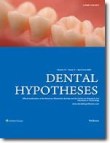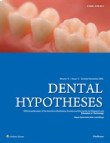فهرست مطالب

Dental Hypotheses
Volume:14 Issue: 2, Apr-Jun 2023
- تاریخ انتشار: 1402/03/30
- تعداد عناوین: 8
-
Pages 45-48Introduction
This research aims to compare the distribution of stresses and general displacements between different dental implant abutments against a healthy tooth, as well as the mechanical behavior of the carbon fiber-reinforced polyether-ether-ketone (CFR-PEEK) material under load conditions.
MethodsA biomodel of a healthy tooth was implemented by computed tomography (CT), considering three essential parts of the tooth (enamel, dentin, and pulp). Three different dental abutments were produced using the SolidWorks computer program. Applying the finite element method (FEM), a numerical evaluation was performed by introducing a critical load of 550N and then unloading it to 0N taking into consideration the behavior of the material (titanium and CFR-PEEK) as bilinear, isotropic, and homogeneous.
ResultsThe difference in stress and total displacement between the dental implant (titanium and CFR-PEEK) and the healthy tooth was significant, going from critical stress values of 1087 to 324 MPa.
ConclusionWhen removing the load from the CFR-PEEK material, it presented residual stresses because the material passed its elastic limit despite this, demonstrating a better mechanical behavior than titanium.
Keywords: Bilinear behavior, dental implant, finite element analysis, numerical analysis, PEEK -
Pages 49-51Introduction
We aimed to compare the changes in the two salivary biomarkers, RANKL and RANK, among patients with healthy gingiva on reduced periodontium versus generalized periodontitis stages II and III.
MethodsStudy subjects were divided into three groups: (1) healthy periodontium (control group) (n=15), (2) generalized periodontitis stages II and III (n=30), and (3) healthy gingiva on reduced periodontium (n=30). Salivary levels of RANKL and RANK were assessed using an enzyme-linked immunosorbent assay. Data analysis was done by the one-way ANOVA and the Tukey post hoc test using R software.
ResultsThere was a statistically significant difference among the three study groups regarding salivary levels of the RANKL (P < 0.001) and RANK (P < 0.001). A Post hoc test showed that the difference between salivary levels of the RANKL (P=0.50) and RANK (P=0.86) among periodontitis groups and healthy gingiva in the reduced periodontium group was not statistically significant.
ConclusionHigh salivary levels of RANKL and RANK in comparison with healthy gingiva are not necessarily associated with the active phase of periodontal disease and progressive bone destruction.
Keywords: ELISA assay, osteoclasts, osteoimmunology, periodontal disease, periodontitis, RANK, RANKL, salivary biomarkers -
Pages 52-54Introduction
We aimed to evaluate the effect of feeding pattern and salivary level of growth hormone on the stage of primary tooth eruption among infants aged 6 to 18 months.
MethodsThe sample size of this analytical cross-sectional study was 300 healthy infants from Karbala, Iraq. Feeding pattern answered by the parents, stage of dental eruption assessed according to criteria described by Damodar P. Swami, and level of salivary growth hormone determined using an ELISA assay.Data were analyzed via a linear regression model using R software.
ResultsThe model (adjusted R2: 0.668) showed the feeding pattern (beast, bottle, or mix), gender, and salivary level of growth hormone were not significant predicators for the stage of primary tooth eruption (p > 0.05). Yet, age was a significant predicator (p < 0.001).
ConclusionThe infant’s feeding pattern and salivary level of growth hormone did not affect the timing of the eruption of primary teeth.
Keywords: Bottle feeding, breastfeeding, ELISA assay, feeding pattern, growth hormone, infant, primary tooth eruption, salivary biomarkers -
Pages 55-58Introduction
We aimed to evaluate serum and salivary vitamin B12 levels in patients with iron deficiency anemia (IDA) with and without recurring aphthous ulcers (RAS).Methods
Study participants were divided into three groups, clinically healthy control group (n = 25), an IDA patient with RAS (n = 25), and an IDA without RAS (n = 25). The enzyme-linked immunosorbent assay (ELISA) method was used to assess the serum and salivary B-12 levels blindly. Data analyses were performed using one-way ANOVA and the Tukey’s post hoc test using R software.Result
There were statistically significant differences regarding serum and salivary B12 levels among study groups (P<0.001). All pairwise comparisons showed significant differences regarding serum (P<0.001) and salivary (P ≤ 0.002) B12 levels.Conclusion
The Control group (396 ± 18.2 pg/mL) was within the normal serum level of vitamin B12 (200-900 pg/mL), while in IDA with RAS (111 ± 15.4 pg/mL) and IDA without RAS (145 ± 57.2 pg/mL) serum level of vitamin B12 is lower than the normal range and significantly lower than the control group.Keywords: Aphthae, ELISA assay, iron deficiency anemia, recurrent aphthous stomatitis, salivary biomarkers, Vitamin B12 -
Pages 59-61Introduction
We aimed to assess the possible relationship between dental caries prevalence and oxidative stress markers such as protein carbonyl (PC) and total antioxidant capacity (TAOC) of saliva among type 1 diabetic children.
MethodsAn analytical cross-sectional study was performed among 45 type 1 diabetic children and compared with 45 healthy control children aged 10 to 12 years old. Dental caries was diagnosed and recorded using the decayed, missing, and filling index (DMFS/dmfs). Unstimulated salivary specimens were collected for evaluation of TAOC and PC using an enzyme-linked immune-sorbent assay (ELISA). A linear regression model and one-way ANOVA test were employed for data analysis using the R 4.3.0.
ResultsSalivary levels of TAOC and PC, having diabetes, and diabetes status (controlled or uncontrolled) were not statistically significant (P > 0.05) predicators regarding the prevalence of dental caries among type 1diabetic children.
ConclusionThe diabetic status had a significant effect on salivary levels of TAOC and PC, but no significant effect on the prevalence of dental caries.
Keywords: Children, dental caries, ELISA assay, oxidative stress, protein carbonyl, salivary biomarkers, total antioxidant capacity, Type 1diabetes mellitus -
Pages 62-65Introduction
We aimed to assess the push-out bond strength of BIO-C REPAIR (a ready-to-use bioceramic material), and compare it with the mineral trioxide aggregate (MTA) and аmаlgаm.
MethodsA total of 30 single-rooted, straight human maxillary central incisors were chosen. To keep the root canal length at 15 mm, the crown was resected. The teeth underwent endodontic treatment, along with the resection of their root ends and preparation of root-end cavities. The teeth were randomly allocated into three groups as follows: BIO-C REPAIR, MTА, and Zinc-free аmаlgаm. Utilizing a universal testing machine, the push-out test was done and the digital microscope was used to assess failure made. Data were analyzed by the one-way ANOVA and chi-square test using the Python software.
ResultsStatistically significant difference was found among study groups regarding push-out bond strength (p <0.001) and mode of failure (p < 0.001). Post-hoc test showed MTA has significantly lower push-out bond strength than BIO-C REPAIR and amalgam (p <0.001).
ConclusionWithin the limitation of this study, the push-out bond strength for BIO-C REPAIR was higher than the MTA and nearly similar to the amalgam.
Keywords: biocerаmic, endodontic surgery, endodontics, mineral trioxide aggregate (MTA), push-out bond strength, retrograde obturation, root-end filling -
Pages 66-68Introduction
Enamel demineralization expressed as white spot lesions (WSLs) has been reported to be associated with both fixed and removable orthodontic appliances.
Case report:
This case report described the management of a patient with clear aligner-related severe enamel demineralization using a modified resin infiltration technique. Microabrasion with Opalustre (Ultradent, Utah, USA) was performed to remove the remineralized enamel surface followed by repeated etching with ICON Etch (DMG, Hamburg, Germany) until the WSLs disappeared after ethanol application. A #12 blade could be used to check whether the superficial layer was demineralized enough for the resin to infiltrate. The ICON-Infiltrant (DMG, Hamburg, Germany) was applied to the etched enamel and light-cured. After treatment, all the WSLs showed improvement with the color nearly matching the adjacent sound enamel.
DiscussionModified resin infiltration technique combined with microabrasion could be an effective noninvasive method to treat severe enamel demineralization including shallow localized enamel breakdown. However, more clinical studies are required to assess the efficacy and safety of this method.
Keywords: aesthetic dentistry, clear aligner, enamel demineralization, microabrasion, resin infiltration, white spot lesion


